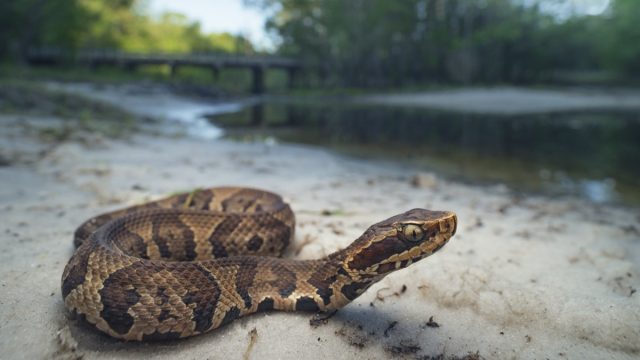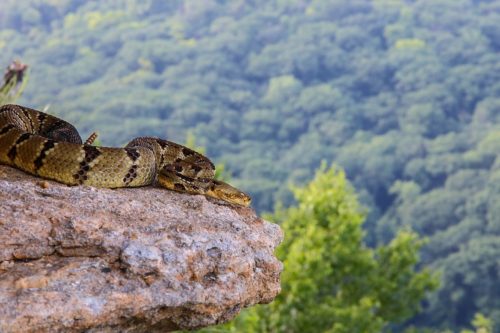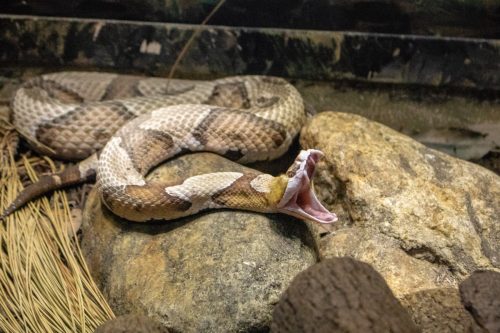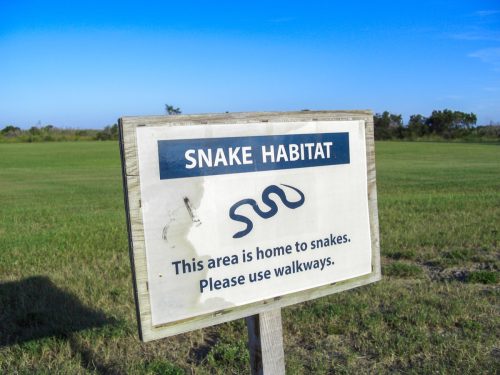If You Live Here, Watch Out for These 6 Venomous Snakes, Experts Say

Seeing a snake can be enough to spark fear in even the bravest among us—especially if that snake is venomous. According to the Centers for Disease Control and Prevention’s (CDC) National Institute on Occupational Safety and Health, between 7,000 and 8,000 people are bitten by venomous snakes in the U.S. annually, and while deaths are rare, you’ll still want to keep your distance if you happen to stumble on one. If you live in a particular part of the U.S., you might encounter these unsettling reptiles, including six venomous varieties. Read on to find out which snakes to watch out for, and what you should do if one crosses your path.
READ THIS NEXT: If You Live Here, Watch Out for This Venomous Snake in Your Backyard.
Snakes like the pleasant summer weather just as much as we do.

Warm weather is welcome in the summer, especially for those of us who like to spend time outside. Unfortunately, snakes also enjoy balmier temperatures, Stewart Flynn of Bug-N-A-Rug Exterminators tells Best Life.
“Snakes are cold-blooded, meaning that they rely on external sources, such as the sun, for a large chunk of their warmth and energy,” he says. “That means that they can often be found laying in the sun to soak up the heat, especially during the summer.”
These reptiles like to make their home in spots where it’s easiest for them to access the necessities—water, shelter, and food. “Since they feed on everything from mice and squirrels to birds, lizards, frogs, and insects, snakes can be found in woods, fields, and near bodies of water,” Flynn explains.
With summer still heating things up, snakes are likely to be out and about until we feel that first autumnal chill. If you live in one state where it gets considerably warm, you’ll want to keep an eye out for snakes when venturing outdoors.
READ THIS NEXT: The No. 1 Place Snakes Love to Hide Before They Strike.
Snakes are especially common here, including venomous ones.

Snakes are relatively common in North Carolina, as the state is home to approximately 38 different varieties, six of which are venomous, according to the North Carolina Wildlife Resources Commission (NCWRC). Venomous snakes include the copperhead, cottonmouth, timber rattlesnake, eastern diamondback rattlesnake, pygmy rattlesnake, and the eastern coral snake.
Interestingly, four of these snakes are protected species in North Carolina, and are not permitted to be handled or distributed, the agency states. Both the timber and pygmy rattlesnakes are “Species of Special Concern,” and the eastern diamondback rattlesnake and eastern coral snake are endangered species.
Snake species prefer different in-state habitats.

Of the venomous varieties found in North Carolina, the copperhead is the one you’re most likely to get struck by, accounting for roughly 90 percent of in-state venomous bites. The copperhead is found across the entire state, including urban portions, and is recognizable by its “coppery brown head.” Cottonmouths, on the other hand, are only found on the Coastal Plain and in some parts of the Outer Banks, the NCWRC says, and coral snakes are a bit rarer and only found in southeast portion of the state, close to the South Carolina border.
The timber rattlesnake covers the most ground of the three rattlesnake varieties, common in forested areas of the North Carolina mountains and the Coastal Plain, while the pygmy prefers pine flatwoods and scrub oak habitats located in the southeastern Coastal Plain, Sandhills, as well as portions of the southern Piedmont region. The eastern diamondback also likes the southeastern Coastal Plain, occupying the “long-leaf pine flatwoods and sandhill habitats,” according to the NCWRC.
For more outdoor advice delivered straight to your inbox, sign up for our daily newsletter.
You can try to identify if a snake is venomous.

If you’re out and about and unsure whether a snake could be dangerous—as many truly are harmless—Flynn has a method for identifying a venomous snake.
“You can tell that a snake is venomous by the shape of its head,” Flynn explains. “While non-venomous snakes have long, slender heads, venomous snakes have triangular heads—this is because they have venom sacks on the sides of their jaws, giving their head its distinctive shape.”
However, this is not a foolproof identifier, as some non-venomous snakes have learned to mimic this feature by flattening their narrow heads to ward off predators, according to National Geographic.
Snakes should be able to coexist with us.

Across the board, experts recommend that if you see a snake, you simply leave it be. For many of us, this probably goes without saying, but you’ll want to avoid fleeing too quickly.
“If you see a snake, leave it alone!” Flynn says, adding that snakes are “shy” and will likely only attack if they’re provoked. “So if you see one, just stop and back away slowly. Don’t try to scare it or move it.”
The NCWRC stresses the importance of leaving snakes be, as they’re a crucial part of the environment. But if you don’t want them in your yard, you can try decluttering, as snakes like “thick cover” to seek their prey. Flynn also recommends keeping an outdoor cat. “Cats can keep the rodent population under control, thereby reducing the food sources of snakes, meaning they are less likely to settle in the area,” he says.
READ THIS NEXT: A Venomous Snake Bit a 7-Year-Old at His Home—Here’s Where It Was Hiding.
Seek medical attention if you end up with a snake bite.

If you are unlucky enough bitten by one of these poisonous varieties, Flynn notes that you’ll need immediate medical attention. While you wait, you should remove jewelry, clean the affected area with soap and water, and try to keep the wound above your heart to slow the spread of the venom, he says—but never try to suck out the venom yourself.
And while it might not seem like an ideal “Kodak Moment,” snapping a photo could actually be helpful for first responders. “If possible, take a picture of the snake—from a safe distance!” Flynn says. “This will help determine the exact type of snake and what anti-venom is required.”